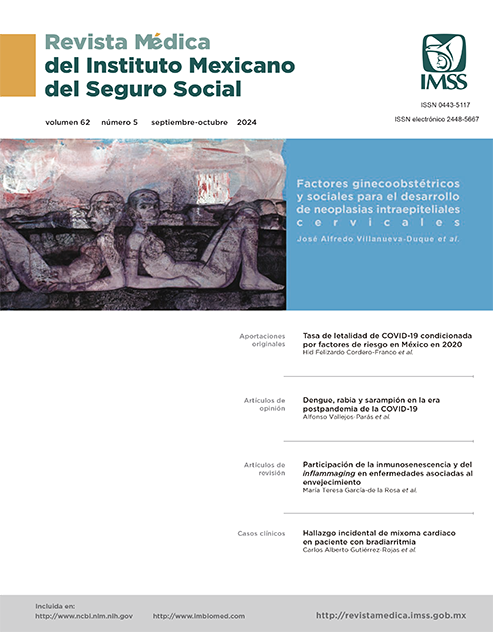Linear power and mortality in COVID-19 respiratory difficulty syndrome
Main Article Content
Keywords
Abstract
Background: Acute respiratory distress syndrome (ARDS) secondary to COVID-19 crowded intensive care units in the world with high mortality. Mechanical ventilation was fundamental in the treatment; however, the evidence of ventilatory markers associated with mortality is not entirely clear. In 2021 it was described the linear power, which was superior to other markers. At the moment its possible utility in patients with ARDS due to COVID-19 has not been described.
Objective: To evaluate linear power as a risk factor for mortality in patients with ARDS due to COVID-19 in intensive care.
Material and methods: Retrospective cohort study in patients admitted to intensive care with ARDS secondary to COVID-19. Linear power was calculated for patients who died and patients who survived in intensive care. Mann-Whitney U test and multivariable Cox regression (hazard ratio [HR] with 95% confidence intervals [95% CI]) were performed.
Results: 60 patients were studied with a mortality of 43.3%. Those who died had a higher linear power (89.5 vs. 78, p = 0.031) and the best cut-off point was 84 cmH2O/rpm (AUC 0.663, p = 0.031, LR 2.02); in addition, those with linear power < 84 (p = 0.050) had a better cumulative survival.
Conclusions: Linear power is a possible risk factor for mortality in patients with ARDS secondary to COVID-19 in intensive care.
References
Umakanthan S, Sahu P, Ranade AV, et al. Origin, transmission, diagnosis and management of coronavirus disease 2019 (COVID-19). Postgrad Med J. 2020;96(1142):753-8. doi: 10.1136/postgradmedj-2020-138234.
Estenssoro E, Loudet CI, Ríos FG, et al. Clinical characteristics and outcomes of invasively ventilated patients with COVID-19 in Argentina (SATICOVID): a prospective, multicentre cohort study. Lancet Respir Med. 2021;9(9):989-98. doi: 10.1016/S2213-2600(21)00229-0.
Verity R, Okell LC, Dorigatti I, et al. Estimates of the severity of coronavirus disease 2019: a model-based analysis. Lancet Infect Dis. 2020;20(6):669-77. doi: 10.1016/S1473-3099(20)30243-7.
Vázquez JB, Menchén DA, Lloréns MMM, et al. Manifestaciones sistémicas y extrapulmonares en la COVID-19. Medicine (Madr). 2022;13(55):3235-45. doi: 10.1016/j.med.2022.05.004.
Yang W, Kandula S, Huynh M, et al. Estimating the infection-fatality risk of SARS-CoV-2 in New York City during the spring 2020 pandemic wave: a model-based analysis. Lancet Infect Dis. 2021;21(2):203-12. doi: 10.1016/S1473-3099(20)30769-6.
Tomicic V, Veliz A, Pizarro S, et al. Características y desenlaces de los pacientes ventilados por neumonía por SARS-CoV-2 en un hospital chileno. Med Crit. 2023;37(2):99-105. doi: 10.35366/110444.
O’Driscoll M, Ribeiro Dos Santos G, Wang L, et al. Age-specific mortality and immunity patterns of SARS-CoV-2. Nature. 2021;590(7844):140-5. doi: 10.1038/s41586-020-2918-0.
Grasselli G, Zangrillo A, Zanella A, et al. Baseline Characteristics and Outcomes of 1591 Patients Infected With SARS-CoV-2 Admitted to ICUs of the Lombardy Region, Italy. JAMA. 2020;323(16):1574-81. doi: 10.1001/jama.2020.5394.
Suleyman G, Fadel RA, Malette KM, et al. Clinical Characteristics and Morbidity Associated with Coronavirus Disease 2019 in a Series of Patients in Metropolitan Detroit. JAMA Netw Open. 2020;3(6):e2012270. doi: 10.1001/jamanetworkopen.2020.12270.
Dal H, Karabulut Keklik ES, Yilmaz H, et al. Estimation of biochemical factors affecting survival in intensive care COVID-19 patients undergoing chest CT scoring: A retrospective cross-sectional study. Medicine (Baltimore). 2022;101(40):e30407. doi: 10.1097/MD.0000000000030407.
Todor SB, Bîrluțiu V, Topîrcean D, et al. Role of biological markers and CT severity score in predicting mortality in patients with COVID‑19: An observational retrospective study. Exp Ther Med. 2022;24(5):698. doi: 10.3892/etm.2022.11634.
Afriyie-Mensah J, Aboagye ET, Ganu VJ, et al. Clinical and therapeutic outcomes of COVID-19 intensive care units (ICU) patients: a retrospective study in Ghana. Pan Afr Med J. 2021;38:107. doi: 10.11604/pamj.2021.38.107.27131.
Alharthy A, Aletreby W, Faqihi F, et al. Clinical Characteristics and Predictors of 28-Day Mortality in 352 Critically Ill Patients with COVID-19: A Retrospective Study. J Epidemiol Glob Health. 2021;11(1):98-104. doi: 10.2991/jegh.k.200928.001.
Tasaka S, Ohshimo S, Takeuchi M, et al. ARDS Clinical Practice Guideline Committee 2021 from the Japanese Respiratory Society, the Japanese Society of Intensive Care Medicine, and the Japanese Society of Respiratory Care Medicine. ARDS Clinical Practice Guideline 2021. Respir Investig. 2022;60(4):446-95. doi: 10.1016/j.resinv.2022.05.003.
Fan E, del Sorbo L, Goligher EC, et al. An Official American Thoracic Society/European Society of Intensive Care Medicine/Society of Critical Care Medicine Clinical Practice Guideline: Mechanical Ventilation in Adult Patients with Acute Respiratory Distress Syndrome. Am J Respir Crit Care Med. 2017;195(9):1253-63. doi: 10.1164/rccm.201703-0548ST.
Hashimoto S, Sanui M, Egi M, et al. The clinical practice guideline for the management of ARDS in Japan. J Intensive Care. 2017;5:50. doi: 10.1186/s40560-017-0222-3.
Roca O, Peñuelas O, Muriel A, et al. Driving Pressure Is a Risk Factor for ARDS in Mechanically Ventilated Subjects Without ARDS. Respir Care. 2021;66(10):1505-13. doi: 10.4187/respcare.08587.
Serpa Neto A, Deliberato RO, Johnson AEW, et al. Mechanical power of ventilation is associated with mortality in critically ill patients: an analysis of patients in two observational cohorts. Intensive Care Med. 2018;44(11):1914-22. doi: 10.1007/s00134-018-5375-6.
Van Meenen DMP, Serpa Neto A, Paulus F, et al. The predictive validity for mortality of the driving pressure and the mechanical power of ventilation. Intensive Care Med Exp. 2020;8(Suppl 1):60. doi: 10.1186/s40635-020-00346-8.
Schuijt MTU, Schultz MJ, Paulus F, et al. Association of intensity of ventilation with 28-day mortality in COVID-19 patients with acute respiratory failure: insights from the PRoVENT-COVID study. Crit Care. 2021;25(1):283. doi: 10.1186/s13054-021-03710-6.
Costa ELV, Slutsky AS, Brochard LJ, et al. Ventilatory Variables and Mechanical Power in Patients with Acute Respiratory Distress Syndrome. Am J Respir Crit Care Med. 2021;204(3):303-11. doi: 10.1164/rccm.202009-3467OC.
Vásquez-Tirado GA, Cuadra Campos MC, Meregildo-Rodríguez ED, et al. Poder mecánico como predictor de mortalidad en pacientes críticos con síndrome de distrés respiratorias agudo por Covid-19 en la unidad de cuidados intensivos. Bol Malariol Salud Ambient. 2022;62(2):251-9. doi: 10.52808/BMSA.7E6.622.016.
Hernández-Pedroza JC, Pinedo LM. Asociación del poder mecánico con la mortalidad en pacientes con COVID-19 grave. Med Crit. 2022;36(6):357-62. doi: 10.35366/107458.


